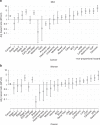The association between unexpected weight loss and cancer diagnosis in primary care: a matched cohort analysis of 65,000 presentations
- PMID: 32291391
- PMCID: PMC7283307
- DOI: 10.1038/s41416-020-0829-3
The association between unexpected weight loss and cancer diagnosis in primary care: a matched cohort analysis of 65,000 presentations
Abstract
Background: We aimed to understand the time period of cancer diagnosis and the cancer types detected in primary care patients with unexpected weight loss (UWL) to inform cancer guidelines.
Methods: This retrospective matched cohort study used cancer registry linked electronic health records from the UK's Clinical Practice Research Datalink from between 2000 and 2014. Univariable and multivariable time-to-event analyses examined the association between UWL, and all cancers combined, cancer site and stage.
Results: In all, 63,973 patients had UWL recorded, of whom 1375 (2.2%) were diagnosed with cancer within 2 years (days-to-diagnosis: mean 181; median 80). Men with UWL (HR 3.28 (2.88-3.73)) and women (1.87 (1.68-2.08)) were more likely than comparators to be diagnosed with cancer within 3 months. The association was greatest in men aged ≥50 years and women ≥70 years. The commonest cancers were pancreas, cancer of unknown primary, gastro-oesophageal, lymphoma, hepatobiliary, lung, bowel and renal-tract. The majority were late-stage, but there was some evidence of association with stage II and stage III cancers. In the 3-24 months after presenting with UWL, cancer diagnosis was less likely than in comparators.
Conclusion: UWL recorded in primary care is associated with a broad range of cancer sites of early and late-stage.
Conflict of interest statement
The authors declare no competing interests.
Figures






References
-
- Rubin G, Berendsen A, Crawford SM, Dommett R, Earle C, Emery J, et al. The expanding role of primary care in cancer control. Lancet Oncol. 2015;16:1231–1272. - PubMed
-
- Hamilton W, Walter FM, Rubin G, Neal RD. Improving early diagnosis of symptomatic cancer. Nat. Rev. Clin. Oncol. 2016;13:740–749. - PubMed
-
- NICE. Suspected cancer: recognition and referral (NG12). (National Institute for Health and Care Excellence, 2015) - PubMed

